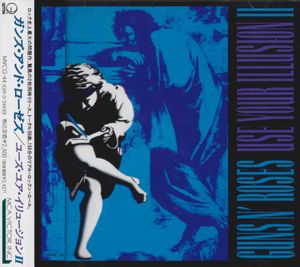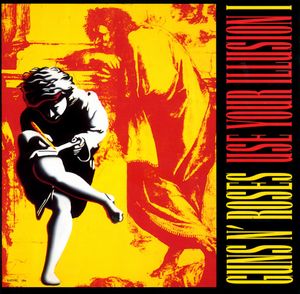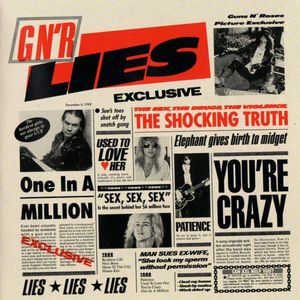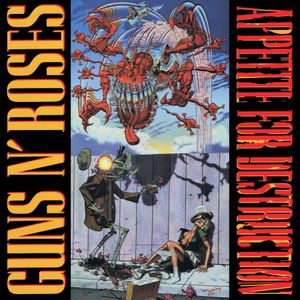
Guns N’ Roses Top 10
Click title to open the Spotify playlist
Guns N' Roses: From L.A. Streets to Rock Legends
Born from the fiery fusion of Hollywood Rose and L.A. Guns in 1985, Guns N' Roses emerged as a force of nature from the heart of Los Angeles. Their "classic lineup," featuring the incendiary vocals of Axl Rose, the blistering guitar of Slash, the gritty rhythm of Izzy Stradlin, the thunderous bass of Duff McKagan, and the relentless drumming of Steven Adler, ignited a firestorm that shook the rock world.
After signing with Geffen Records, the band's debut album, "Appetite for Destruction" (1987), initially met with lukewarm reception. But a grassroots movement fueled by the infectious "Welcome to the Jungle" video catapulted the album into the stratosphere. The world was introduced to the band's signature blend of punk, blues, and heavy metal, a potent cocktail that redefined mainstream rock, pushing it away from the glam metal excesses of the era. "Welcome to the Jungle" and "Paradise City" became anthems, while "Sweet Child o' Mine" soared to the top of the Billboard Hot 100, cementing the band's iconic status. With over 30 million copies sold worldwide, "Appetite for Destruction" became the best-selling debut album in the US and a defining record of the 80s.
Guns N' Roses weren't content to rest on their laurels. "G N' R Lies" (1988) followed, a powerful blend of raw live energy and introspective acoustic tracks. The album's hit, "Patience," showcased the band's versatility, while the controversial "One in a Million" reflected their raw honesty and willingness to push boundaries. "G N' R Lies" solidified their position as a force to be reckoned with, achieving commercial success and critical acclaim.
Guns N' Roses weren't just about scorching riffs and rebellious anthems; they revitalized the power ballad, proving their ability to craft deeply emotional and melodic music. Their music became the soundtrack of a generation, reflecting the raw energy, rebellion, and complexities of a world on the cusp of change. Through it all, Guns N' Roses remained a constant, a testament to the power of raw talent, relentless passion, and a refusal to be confined by genre or expectation.
Slash’s lightning-rod riffs, Axl Rose’s untamed wail, and a rhythm section steeped in street-wise swagger—Guns N’ Roses distilled danger and grandeur into some of rock’s most unforgettable tracks. In this countdown we revisit ten songs that define the band’s legacy, spanning the snarling energy of “Welcome to the Jungle,” the tender roar of “Sweet Child O’ Mine,” and the cinematic sweep of “November Rain.” Whether you crave hard-charging riffs, stadium-sized ballads, or blistering guitar solos, these essentials capture why GNR remains a benchmark for raw, unfiltered rock-and-roll power.
Our Selection Methodology
These songs were carefully selected based on cultural impact, musical innovation, streaming popularity, and their significance in the band's discography.
🏆 Top 3 Greatest Songs
Why "Estranged" is #1
A nine-minute, multi-section epic, “Estranged” pushes the Illusion era’s ambition to its limit. Built on complex chord progressions and tempo shifts, the track allows Slash multiple lyrical solos that ebb and flow with Axl’s introspective narrative. Dizzy Reed’s piano and subtle orchestration add symphonic gravitas. The lyrics delve into existential loneliness and self-reconciliation, devoid of chorus repetition—a rarity in mainstream rock. Its lavish video, part of an unofficial trilogy with “Don’t Cry” and “November Rain,” depicts Axl adrift at sea and rescued by dolphins—an emblem of the band’s theatrical excess. “Estranged” remains a cult favorite among fans who cherish GNR’s grandest flights of creativity.
Why "You Could Be Mine" is #2
Chosen as the theme for Terminator 2, this adrenaline-fueled rocker features one of Matt Sorum’s most punishing drum performances and Slash’s whirlwind riffing. The song’s breathless verses and venomous chorus—“With your bitch-slap rappin’ and your cocaine tongue”—capture Axl at his snarling best. Its lyrical venom targets a toxic relationship, channelled through rapid-fire phrasing that mirrors the relentless instrumental assault. The high-profile movie tie-in introduced GNR to a global blockbuster audience, while the band’s cameo alongside Arnold Schwarzenegger cemented their pop-culture ubiquity.
Why "Don’t Cry" is #3
“Don’t Cry” exists in two official studio versions—original lyrics on Use Your Illusion I and an alternate take on Illusion II—underscoring Axl’s perfectionist streak. A delicate arpeggiated riff sets a wistful tone before the full band swells beneath soaring vocal lines. Shannon Hoon of Blind Melon contributes harmonies, enriching the track’s emotional depth. The song grapples with bittersweet partings and lingering affection, highlighted by dual guitar solos that intertwine melody and drama. Its cinematic video, laden with surreal imagery, fed into the Illusion era’s myth-making. “Don’t Cry” bridges the brute force of early GNR with their later, more expansive songwriting ambitions.
📊 Complete Rankings
Patience
Recorded for the stop-gap G N’ R Lies EP, “Patience” strips the band down to three acoustic guitars and a whistle solo. The sparse arrangement spotlights Axl’s heartfelt vocal and the group’s surprising knack for harmony vocals—an often-overlooked facet of their sound. Slash’s tasteful acoustic fills demonstrate that his expressive phrasing transcends amplification. The lyrics meditate on relational perseverance, offering empathy unusual for late-’80s hard rock. Its unplugged vibe broadened GNR’s audience, paving the way for the balladry of the Use Your Illusion albums. Onstage, the song often morphs into an electric crescendo, proving its adaptability and enduring appeal.
Civil War
Opening with a haunting whistle and a sample of the film Cool Hand Luke, “Civil War” unfolds as a slow-burn protest anthem. Axl’s acoustic strumming and Slash’s slide guitar create an eerie atmosphere before the full band erupts into a mid-tempo march. The track’s shifting time signatures and layered guitars highlight the group’s evolving compositional ambition. Lyrically, it condemns senseless conflict—from Vietnam to inner-city violence—asking, “What’s so civil about war, anyway?” Axl’s emotive delivery, paired with Duff’s melodic bass work, transforms political commentary into visceral art. Released during the Gulf War era, the song underscored GNR’s willingness to tackle weightier themes beyond sex, drugs, and decadence.
Paradise City
With its chant-along intro—“Take me down to the Paradise City!”—this track invites instant crowd participation. The verse’s relaxed, almost funky groove contrasts sharply with the chorus’s turbo-charged power chords, showcasing the band’s dynamic range. Live, the song often stretches past seven minutes, giving Slash room for extended shredding and turning arenas into communal sing-alongs. Lyrically, “Paradise City” fuses nostalgia and escapism, painting a hazy dream of an idyllic refuge from urban decay—a theme that resonates with fans seeking release. Its escalating double-time finale, propelled by Adler’s furious kick-drum pattern, epitomizes GNR’s ability to marry melody with break-neck intensity, ensuring its place as a set-closing staple.
November Rain
Clocking in at nearly nine minutes, “November Rain” is a power-ballad epic that blends rock grandeur with classical ambition. Dizzy Reed’s sweeping piano motif lays a melancholic foundation, over which orchestral strings and Slash’s lyrical guitar leads weave emotional counterpoints. Matt Sorum’s restrained drumming builds patiently until the final act, when crashing cymbals and choral backing vocals push the song into cathartic overdrive. Axl’s lyrics explore love’s fragility and the inevitability of change, delivered with operatic intensity that underscores his cinematic vision. The extravagant music video—replete with gothic cathedrals, wedding scenes, and Slash’s windswept desert solo—became a cultural landmark of the MTV era. “November Rain” showed that GNR could transcend hard-rock swagger to craft a melodramatic opus worthy of classic rock’s grandest traditions.
Welcome to the Jungle
From the menacing feedback at the start, “Welcome to the Jungle” plunges listeners into a gritty portrait of L.A.’s underbelly. Slash and Stradlin trade stabbing chords and serpentine licks while Adler’s hyper-kinetic drumming propels the track forward. Axl’s feral screams and rapid-fire phrasing capture the danger and allure of urban excess, echoed by McKagan’s punk-inflected bass drive. The song’s relentless energy and graphic lyricism made it an instant statement of intent: GNR were raw, unpredictable, and impossible to ignore. MTV’s heavy rotation of the video—featuring Axl as a wide-eyed newcomer corrupted by city vice—helped catapult the band to superstardom. Decades later, its opening riff still electrifies arenas and movie trailers alike, serving as shorthand for unbridled rock ’n’ roll chaos.
Nightrain
Named after a cheap Californian fortified wine favored by the band, “Nightrain” is pure, unfiltered Appetite-era swagger. A slashing open-chord riff and Duff’s galloping bass launch the song into a high-speed ode to reckless partying. Axl’s rasp cuts through with exuberant yelps, celebrating the hedonistic highs and inevitable hangovers of life on the edge. The track’s straightforward, blues-soaked solo and chant-along bridge distill everything electrifying about early GNR: raw energy, streetwise attitude, and a killer hook. Though never released as a major single, “Nightrain” ranks among the band’s most requested live numbers—proof that visceral groove sometimes outlasts radio play.
Sweet Child O’ Mine
Slash’s shimmering, octave-jumping intro riff is one of rock’s most recognizable hooks—written almost as a warm-up exercise before morphing into the centerpiece of Appetite for Destruction. The interplay between Duff McKagan’s buoyant bass line and Steven Adler’s loose, swinging groove gives the song a lighter feel than most of the album’s street-tough material. When the chorus lands, Axl Rose’s soaring vocal range lifts the melody into stadium-anthem territory while Izzy Stradlin’s rhythm guitar locks everything in place. Lyrically, the track stands out for its tenderness. Inspired by Axl’s then-girlfriend Erin Everly, it trades the band’s usual grit for unabashed romance, proving GNR could wield sentimentality without losing edge. The climactic, double-time outro—marked by Slash’s fluid soloing and Axl’s urgent refrain of “Where do we go now?”—cements “Sweet Child O’ Mine” as both a radio mainstay and a virtuoso showcase.
🎵 Why These Tracks Define Musical Excellence
This carefully curated ranking represents the pinnacle of Guns N’ Roses Top 10 artistic achievement. Each song has earned its place through a combination of cultural impact, musical innovation, and enduring popularity among fans worldwide.
Cultural Impact
Songs that shaped music history and influenced countless artists
Fan Favorites
Tracks with millions of streams and lasting popularity across generations
Related Video
Last Modified: 4/24/2025




